Introduction
Overall Design
{{section_header}}{{section.name}}{{/section_header}}
The TV looks attractive, but lacks the tech chic of other 2010 models. Sure, it's very thin, but the overall design isn't the best we've seen. Many of the big name manufacturers are doing some very interesting things with TV design, and LG seems to be one step behind.
That being said, there's a very slim chance your buying decision will hinge on the minor aesthetic differences between the 55LE8500 and any other 2010 model.
Front
{{section_header}}{{section.name}}{{/section_header}}
The TV has a thick bezel, but compared to the huge screen size, it doesn't seem disproportionately thick. The bezel is glossy black and picks up fingerprints like crazy. On the bottom right corner you'll find some touch controls, the labels of which are very hard to see.

Back
{{section_header}}{{section.name}}{{/section_header}}
The back of the TV is relatively featureless, save the cluster of ports off to the right hand side. Also, the power cord on your TV should be a full-length cord, not one that fades off into a white void.

Sides
{{section_header}}{{section.name}}{{/section_header}}
There's not much to the TV's sides since it's so thin. The left side has a handful of ports that are indented a few inches from the edge.

Stand/Mount
{{section_header}}{{section.name}}{{/section_header}}
The TV's stand isn't very fancy looking, but goodness gracious is it ever sturdy. The stand has a metal core and connects to a metal supports that fits on the back side of the display. This is a heavy TV, but we have no doubts this stand can manage it.

Controls
{{section_header}}{{section.name}}{{/section_header}}
The TV has a series of touch controls on the bottom right corner of its face. They're very, very hard to see, and as such, we couldn't get a great picture of them. As photographers, we have failed you, the reader, and ourselves as well.
Remote Control
{{section_header}}{{section.name}}{{/section_header}}
The remote is fairly standard for an LG TV. The only difference is the small groove under the volume and channel keys, to give your index finger something to grip.

In the Box
{{section_header}}{{section.name}}{{/section_header}}
The TV comes with a remote, a smaller and simpler remote, two sets of batteries, two A/V adaptors for the 3.5mm ports on the TV's side, a screen wipe, a paper and CD-based manual, and all the appropriate paperwork.
Black Level
{{section_header}}{{section.name}}{{/section_header}}
We measured the LG 55LE8500's black level at a ridiculously high 0.42 candelas per square meter (cd/m2). A typical, good black level is around 0.1 cd/m2. This is four times as bright. Really poor performance here. More on how we test black level.
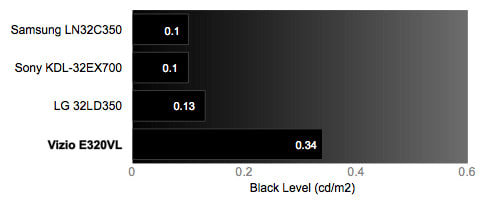
Peak Brightness
{{section_header}}{{section.name}}{{/section_header}}
We measured the 55LE8500s' peak brightness at 427.92, which is bright enough for just about anyone. A high peak brightness is important, because it allows for better detailing in bright scenes and prevents your picture from getting washed out by external light. More on how we test peak brightness.
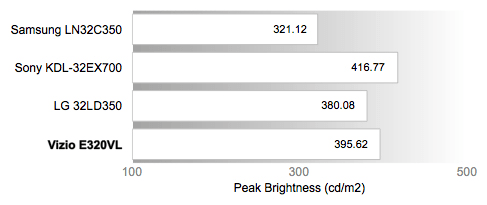
Contrast
{{section_header}}{{section.name}}{{/section_header}}
With a poor black level and very high peak brightness, the 55LE8500 wound up with the mediocre contrast ratio of 1018:1. Our eyesight is based on contrast, so a high contrast ratio is important for maintaining a high level of detail. The 55LE8500 isn't so bad the average viewer would be disgusted, but if the TV was put up against one with a decent contrast ratio, they'd definitely notice. More on how we test contrast.

Tunnel Contrast
{{section_header}}{{section.name}}{{/section_header}}
Tunnel contrast refers to the TV's ability to maintain a solid black level, regardless of how much black is on the screen. The 55LE8500 was able to maintain a fairly solid black level, with the exception of the dim on a 100% black screen. More on how we test tunnel contrast.
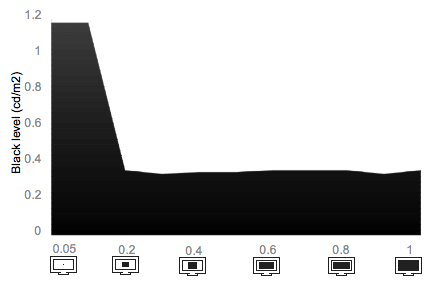
White Falloff
{{section_header}}{{section.name}}{{/section_header}}
The TV has a very consistent white level. It doesn't matter how much white is onscreen at once: the TV maintains the level regardless. More on how we test white falloff.
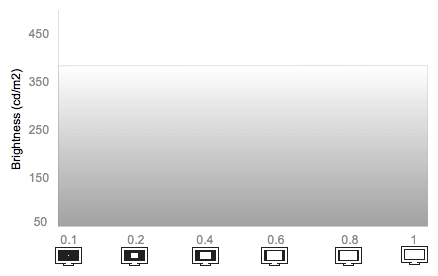
Uniformity
Greyscale Gamma
{{section_header}}{{section.name}}{{/section_header}}
We measured the LG 55LE8500's greyscale gamma at 2.64, which is a bit aggressive. This means some minor details might be lost as the blacks aggressively brighten to whites. Looking at the curve below, you shouldn't run into any additional problems: the gamma increases uniformly. More on how we test greyscale gamma.
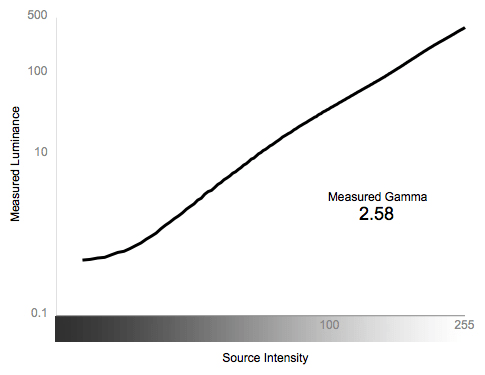
Color Temperature
{{section_header}}{{section.name}}{{/section_header}}
The main issue with the LG 55LE8500's color temperature is its baseline. We try to get the TV's color temperature as close to the ideal 6500K as possible. In the 55LE8500's case, the lowest we could get the temperature was about 9000K, which looks more blue than it should be.
Even though the starting color temperature was less than ideal, the TV didn't stray too far outside the perceptible limits. Certain shades of grey will be a bit warm or cool, but the overall spectrum is pretty neutral. More on how we test color temperature.

RGB Curves
{{section_header}}{{section.name}}{{/section_header}}
The 55LE8500 performed well here. In the graph below, we've plotted to TV's red, green, and blue channel performances. The curves are a bit bumpy, which indicates minor losses of detail. Toward the right end of the graph, you can see green peaking out a bit early, meaning bright greens will look a bit flat. More on how we test RGB curves.

Below we've plotted the TV's red, green, and blue performances as gradient strips. We've also listed a few competing TVs' performances. Look for vertical bands of color and where the strip fades to black. Bands of color indicate a loss of detail, and fading to black too quickly means darker colors will look flat.
Motion Performance
{{section_header}}{{section.name}}{{/section_header}}
Motion Smoothness (7.75)
Blur is significantly reduced by the 240Hz mode. We didn't really see much improvement between the 'high' and 'low' settings, however, so you should probably stick to low, given the artifacting the feature causes. Also, 240Hz causes some crazy artifacting in movies.
With 240Hz on low, the TV did pretty well with 1080p playback. We saw minor blurring, which lead to some lost detail, but nothing major. We saw a lot more blurring on 1080i playback, unfortunately, regardless of the 240Hz setting. It wasn't so much to totally ruin the 55LE8500's otherwise good score in this area, but it did bring it down.
Motion Artifacting (7.00)
The 240Hz mode has the potential to cause some serious artifacting issues, but as long as you keep it set to low, you should be ok. On 1080p playback we hardly noticed any issues at all, just some minor shuddering. Solid blocks of color might distort slightly as they move across the screen, creating little tails behind them in addition to the normal shadowing we typically see. On 1080i playback, the shuddering got significantly heavier, so bad that fine patterns had portions that flashed. Fortunately, although these issues were noticeable, they were fairly rare in occurrence. More on how we test motion performance.
3:2 Pulldown & 24fps
{{section_header}}{{section.name}}{{/section_header}}
On our 3:2 pulldown and 24p tests, we put Real Cinema Mode on, which helps reduce judder and artifacting. We also switched off every flavor of 240Hz, because they caused all kinds of flashing badness.
The 55LE8500 did well on our SMPTE pattern test, with only rare, random instances of fine patterns flashing. A second test uses footage of a slow pan across an empty stadium. Here, we noticed a crawling effect over the backs of the seating that was a bit worse than what we typically see from a TV in the 55LE8500's class. More on how we test 3:2 pulldown and 24fps.
Resolution Scaling
{{section_header}}{{section.name}}{{/section_header}}
Chances are, your TV will be displaying a lot of content that's not within the TV's native resolution. Standard definition broadcast is in 480p, DVDs come in 720p, broadcast HD content runs at 1080i, and Blu-rays use 1080p. Here, we test how well the TV performs showing non-native content. More on how we test resolution scaling.
480p
While we didn't see any major issues with 480p content, we did see a handful of minor ones. We noticed some slight shimmering on fine patterns, and some edges were a bit soft. Overall, though, the 55LE8500 did well at this resolution.
720p
This is where we started having some issues. We saw some very minor coloration in patterns alongside the shimmering effect mentioned above. This means fine patterns might have a slight pale green tint, probably not enough you'd notice. Some finer details blurred together. For example, a set of alternating black and white lines looked almost like a solid grey block. It was very hard to see the individual lines.
1080i
Here we saw all the issues from 720p, only magnified in severity. Fine patterns had all kinds of false coloration, ranging from pale green to greenish grey. The shimmery effect was also worse. Small font was hard to read, which might've been due to the weird sharpness rules mentioned above.
Formats
{{section_header}}{{section.name}}{{/section_header}}
The LG 55LE8500 is a 1080p HDTV, which is currently the highest-resolution HD format.
Viewing Angle
{{section_header}}{{section.name}}{{/section_header}}
Unless you have an awesome position on the couch, you're not going to be viewing your TV from dead center. As you get further away from that spot, you'll actually see a lower contrast ratio in the picture. Due to how their screen technology works, LCDs have the biggest problem with viewing angle.
For this test, we measure the point at which you're only getting half of the TV's maximum contrast ratio. We measured the 55LE8500's viewing angle at a total of about 59°. That means once you get to be about 30° off center, your picture quality will be horrible. This is a decent viewing angle for an LCD, but plasmas can get up to a full 180° without dropping below 50% contrast ratio.

Reflectance
{{section_header}}{{section.name}}{{/section_header}}
The face of the LG 55LE8500 is almost a mirror. If the picture is dark and the room isn't, you'll catch reflections of yourself. If there's an external light that's shining on the screen, it'll create vertical and horizontal streaks that can be somewhat distracting.
Video Processing
{{section_header}}{{section.name}}{{/section_header}}
The LG 55LE8500 has a handful of video processing features. None of them did anything particularly noteworthy, mainly because video processing features rarely do anything noteworthy.
Calibration
{{section_header}}{{section.name}}{{/section_header}}
We calibrate TVs before we test them, to make sure we're scoring them based on their best possible performance. Below we've listed our settings, just in case you feel like using them.
One thing we should mention: the LG 55LE8500, like many LG TVs, has wonky sharpness controls. At default sharpness settings, you'll see some obvious sharpness artifacting. If you turn the H Sharpness below 44, however, you'll get a false coloration effect, and fine patterns will acquire a noticeable green tint.

All of our calibration is done in conjunction with the DisplayMate software.
](http://www.displaymate.com/)
Video Modes
{{section_header}}{{section.name}}{{/section_header}}
The LG 55LE8500 has a handful of video modes for your perusal, although it isn't very specific on what they do. The modes you can choose from are Vivid, Standard, Natural, THX Cinema, Sport, and Game. Most of these modes have a certain TV-applicable connotations, but their specific function isn't listed on the TV or the manual. The TV offers no description, and the manual's explanations range from, 'optimizes video and audio for sports,' to 'optimizes video and audio for games.'
Ergonomics & Durability
{{section_header}}{{section.name}}{{/section_header}}
The LG 55LE8500's remote is a long, thin plastic affair, full of large, colorful buttons. The remote felt well-balanced in hand, with thumb placed on the center of the d-pad. The remote is designed a bit differently from old LG remotes: the d-pad is located towards the bottom instead of the top. This actually puts more of the important buttons closer to the natural grip position. The remote is pretty light, but well-balanced and features a textured underside to help maintain grip.
Button Layout & Use
{{section_header}}{{section.name}}{{/section_header}}
The remote isn't bad overall, but its shape means you'll have to shift your grip a lot. The labeling is clear and easy to understand, but still hard to read when the remote is only illuminated by the remote's light. Fortunately, it's pretty easy to find the large volume and channel buttons without looking at the remote. The main issue here was we had to point the remote almost directly at the RF sensor on the TV in order to get it to respond. Sometimes the TV was a bit sluggish to register button presses, leading to doubled input and a sad sense of frustration.
Programming & Flexibility
{{section_header}}{{section.name}}{{/section_header}}
The LG's remote can be used with other LG devices, using their proprietary SIMPLINK technology.
Connectivity
{{section_header}}{{section.name}}{{/section_header}}
Input Ports (7.5)
The TV has the following input ports:
* 4 HDMI
* 3 Component
* 2 Composite
* 1 VGA
* 3 Analog Audio
* 1 3.5mm Audio
Output Ports (1.0)
There's a single digital audio output port.
Other Connections (6.0)
The TV has an ethernet port and supports DLNA. You can read more about the TV's internet features on our Multimedia & Internet page.
Media (2.0)
There's also two USB ports, for picture, video, and music playback.
Below you'll find a table comparing the LG's connectivity to a few competitors.

Placement
{{section_header}}{{section.name}}{{/section_header}}
The ports are arranged in an intelligent fashion, with a handful located on the TV's side and the rest grouped together in a cluster on the back, close to the edge.
Audio Quality
{{section_header}}{{section.name}}{{/section_header}}
The LG 55LE8500's speakers weren't bad, but they weren't great either. The TV has a surround sound mode, but we wouldn't say it created an enveloping soundspace as much as it made the audio sound a lot less flat and made the bass audible. Pretty average overall for a set of built-in speakers.
Menu Interface
{{section_header}}{{section.name}}{{/section_header}}
The 55LE8500 has a typical LG menu system. The main menu screen is a 5x2 grid of icons that make up the different main menu headers.

Selecting most icons brings you to this screen, with the icons listed down the left, opening up to the right.

Instruction Manual
{{section_header}}{{section.name}}{{/section_header}}
The 55LE8500's manual is pretty good. It has great pictures The only thing it does well is pictures, which are very detailed and employed frequently, if they are a bit small. The table of contents is very limited, there isn't an index (although there is a brief appendix), and the pages aren't tabbed. The font size is a bit on the small side, but shouldn't be a problem for most people.
You can find the LG 55LE8500's manual online here.

A manual for so many TV models, they have to be further categorized by type.
Internet Features
{{section_header}}{{section.name}}{{/section_header}}
The LG 55LE8500 has a basic array of internet feature that includes a few big names like YouTube and Vudu. Basically, the main provider here is Netflix. If you want Netflix, the LG will accommodate; if you want a lot of content options, try a Sony instead.
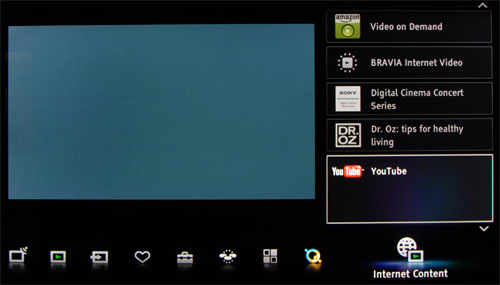
| Service | Our Description |
| Yahoo! TV Widgets | Yahoo! currently widget line-up: weather, a quiz game, sudoku, a Texas Hold'em game, sports (both from Yahoo! and USA Today), videos, finance, news, Flickr, and Twitter. |
| Netflix | This is the biggest name in streaming video nowadays. With an account, you can watch an incredible amount of streaming content. |
| Vudu | Pay-per-view service that specializes in HD videos. They seem to have a decent collection of movies, but paying $25 for a virtual Blu-ray seems pretty steep. |
| YouTube | It's YouTube, only a bit more awkward since you have to navigate with a TV remote. |
| Picasa | It's an online photo album feature, like Flickr, but without the strength of brand. |
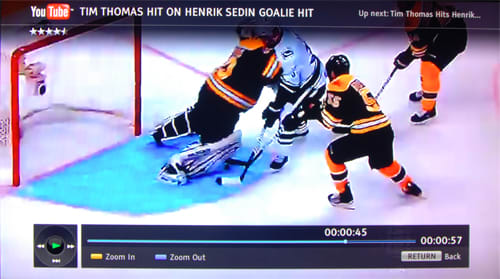
The YouTube playback is a wonderful thing.
Local Media Playback
{{section_header}}{{section.name}}{{/section_header}}
The LG 55LE8500 supports photo playback from a connected USB device. The interface involves a file browser view with the option for fullscreen view. There is no slideshow option, so you'll need to move between photos with the remote. You can have music from the USB drive play in the background.
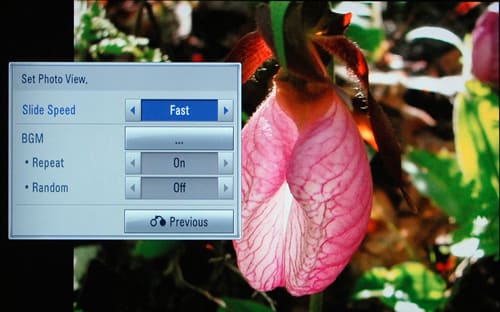
The LG 55LE8500 can also play back MP3 music files. The interface is similar to the one described above, with a file browser view and separate screen for playback. It's a very bare-bones implementation of the feature, but it gets the job done.
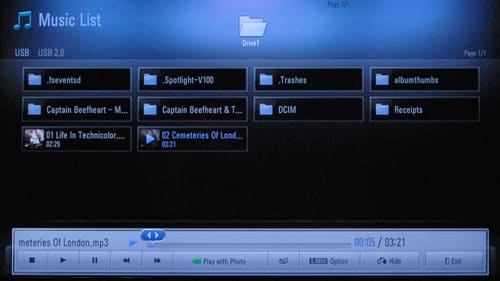
Other Media
{{section_header}}{{section.name}}{{/section_header}}
There are no other media options available.
Power Consumption
{{section_header}}{{section.name}}{{/section_header}}
This TV won't cost you that much money. Even with its backlight burning bright, the LG 55LE8500 will cost less than $3.50 per month. This is pretty cheap for a TV this size.
Below we've stacked the LG 55LE8500 up against some competing models of roughly similar screen sizes. None of them are particularly expensive, although the Panasonic, a plasma, costs significantly more than the three LCDs.
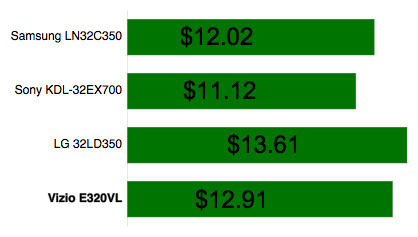
Value Comparison
{{section_header}}{{section.name}}{{/section_header}}
The Panasonic offers a lot more than the LG does and manages to cost less. Not only does it have better overall picture quality, it also gives the option of 3D.
Blacks & Whites
{{section_header}}{{section.name}}{{/section_header}}
The Sony's black level is significantly darker than the LG's. Even though the LG has a slightly brighter peak white, it still has a lower overall contrast ratio.

Color Accuracy
{{section_header}}{{section.name}}{{/section_header}}
The two TVs had roughly the same color performances.
Motion
{{section_header}}{{section.name}}{{/section_header}}
The Panasonic had slightly better processing than the LG.
Viewing Effects
{{section_header}}{{section.name}}{{/section_header}}
As a plasma, the Panasonic has a huge advantage here; the LG's LCD display doesn't even come close to the Panasonic's viewing angle.
Connectivity
{{section_header}}{{section.name}}{{/section_header}}
The two TVs are roughly equivalent in terms of their connectivity options. Both have ethernet ports and about the same caliber of online features. The Panasonic does have an SD card slot for easy photo viewing, but that's really the only significant difference between the two TVs.
Value Comparison
{{section_header}}{{section.name}}{{/section_header}}
The LG is the same price as the Samsung, but is larger, has fewer online content options, doesn't come with 3D, and didn't perform as well on our picture quality tests.
Blacks & Whites
{{section_header}}{{section.name}}{{/section_header}}
The Samsung is significantly darker than the LG. Even though it's not as bright, the Samsung's deep black was enough to give it a higher overall contrast ratio.

Color Accuracy
{{section_header}}{{section.name}}{{/section_header}}
The Samsung's color temperature gets very warm towards the dark end, making the blacks look a bit pink.
Motion
{{section_header}}{{section.name}}{{/section_header}}
The Samsung's processing allowed for sharper moving images, but it had slightly more artifacting issues than the LG.
Viewing Effects
{{section_header}}{{section.name}}{{/section_header}}
The LG had a slightly larger viewing angle than the Samsung, but not by any great stretch.
Connectivity
{{section_header}}{{section.name}}{{/section_header}}
The Samsung has significantly fewer ports, even though the LG is just about as thin. What it does have, however, is a better line-up of online features, if only by a small margin.
Value Comparison
{{section_header}}{{section.name}}{{/section_header}}
The Sony is pretty objectively the better choice here. The LG is more expensive and doesn't offer anything compelling to make up for that price difference.
Blacks & Whites
{{section_header}}{{section.name}}{{/section_header}}
The LG has some issues with its black level. The Sony has a decent black level and a higher overall contrast ratio.

Color Accuracy
{{section_header}}{{section.name}}{{/section_header}}
The Sony seems to get warm and stay there, where the LG is slightly more erratic but less noticeable.
Motion
{{section_header}}{{section.name}}{{/section_header}}
The Sony had marginally better processing, offering a slightly less blurry, artifacty image.
Viewing Effects
{{section_header}}{{section.name}}{{/section_header}}
The LG's viewing angle was marginally better than the Sony's. Neither one is particularly good compared to a plasma, a role fulfilled in the below graph by the Panasonic.
Connectivity
{{section_header}}{{section.name}}{{/section_header}}
The main advantage of the Sony is its line-up of online content. The LG gets the basics from its LAN connection, but Sony offers dozens content options.
Conclusion
The LG 55LE8500 is not a bad TV by any stretch. It didn't get the best results on our picture quality tests—especially its black level, which was significantly brighter than it should have been—but it wasn't a bad TV. The main problem the 55LE8500 has is it's currently priced way, way too high. It's competing with the over-priced 3D HDTVs and it doesn't even have a comparable feature set. Expect the price on this model to fall considerably. When it does, this TV might make a good alternative to some of its competitors, assuming their prices don't also drop.
Model Series Comparison
{{section_header}}{{section.name}}{{/section_header}}
The LE 8500 series is an internet-capable series of 1080p LCDs with a 240Hz feature. The TVs are also 'wireless ready,' which means the TV has a port for a wireless adapter.
Photo Gallery
{{photo_gallery "Front Tour Image", "Back Tour Image", "Sides Tour Image", "Stand Photo", "Controls Photo", "Remote Control Photo", "Connectivity Tour Image 1", "Connectivity Tour Image 2", "Connectivity Extra Photo", "Menu Main Photo", "Menu 2 Photo", "Internet Features 1 Photo", "Internet Features 2 Photo", "Internet Features 3 Photo", "Local Media Playback 1 Photo", "Local Media Playback 2 Photo"}}
Ratings & Specs
{{manufacturer_specs_table}}
Meet the tester
Mark Brezinski works on the Home Team, reviewing refrigerators, minifridges, dishwashers, washing machines, dryers, air conditioners, air purifiers, and fans.
Checking our work.
Our team is here for one purpose: to help you buy the best stuff and love what you own. Our writers, editors, and lab technicians obsess over the products we cover to make sure you're confident and satisfied. Have a different opinion about something we recommend? Email us and we'll compare notes.
Shoot us an email
